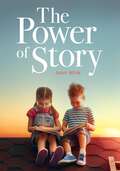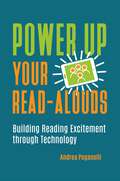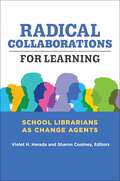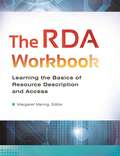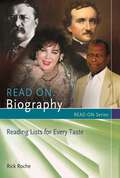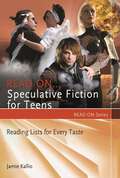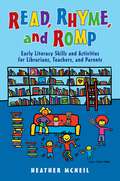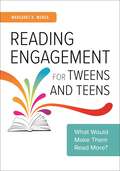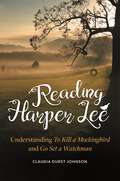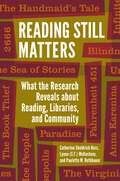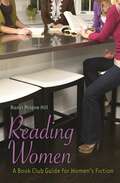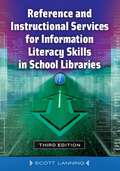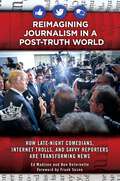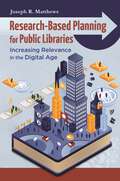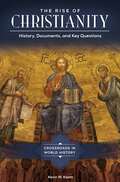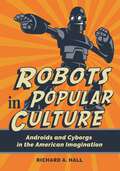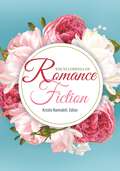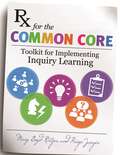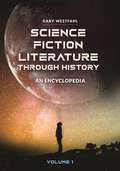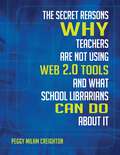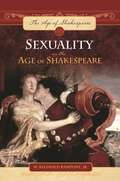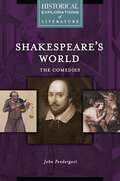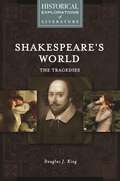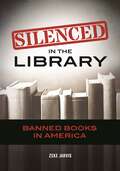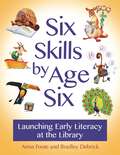- Table View
- List View
The Power of Story
by Joan Wink Ph.D.Through this book, readers will discover that stories can move the human heart and head in ways that research cannot.Stories bring together readers, writers, librarians, teachers, students, and families in the libraries of today and will continue to do so tomorrow. Written for all those lovers of literacy, this book links libraries and literacies through the power of stories. The book is not filled with data in the form of pie charts, graphs, and tables. Rather, the truth of the research is grounded in authentic stories that reflect not only the interpretation of data, but also the transformative nature of literacies and libraries. The author's primary goal is that readers will come to value and use storytelling in their own professional and personal lives to explain and expand on complex concepts and to make information more accessible for all.The book begins by presenting anecdotes and the author's personal story to lay the foundation for what literacies are, and what literacy is not. An activity, "Spiral of Literacy," allows readers to reflect on their own literacies. Chapters that follow each begin with a story that sets the theoretical foundation. Each chapter concludes with an action section that demonstrates how to turn theory to practice, whether you are in a library, a classroom, or at home. A final chapter envisions what libraries might look like in 10 years, through interviews with librarians, teachers, and others interested in literacy.
Power Up Your Read-Alouds: Building Reading Excitement through Technology
by Andrea PaganelliCapture the hearts, minds, and attention of your digital-age listeners using read-aloud experiences that engage technology."I wish my learners would be as excited about reading as they are about technology" is a lament frequently sung by those who seek to support reading development. There is no debate that reading is fundamental and that reading aloud strongly supports lifelong reading engagement. Technology, however, is ubiquitous in our society, and engagement with it is essential for our success. Reading and technology are therefore in competition for learners' attention, but by combining reading and technology through use of read-aloud, facilitators can create engaging digital read-aloud programs to enhance the learning experience. Digital read-aloud can be used with multiple age groups, in a variety of settings, and with differing degrees of expense and technology complexity. Understanding that these myriad options can be overwhelming, however, Andrea Paganelli offers detailed information on the background, implementation, evaluation, and sustainability of technology-infused read-aloud for reading support persons, school librarians, public librarians, instructional librarians, teachers, and professors. Her ideas span multiple ages and subjects and include practical examples designed to engage both educators and readers.
Radical Collaborations for Learning: School Librarians as Change Agents
Librarians can be effective catalysts and vital connectors who facilitate successful partnerships that enrich students' lives—"radical collaborations" that have deep and far-reaching impact.Envisioning schools as learning organizations requires collaborating with the greater communities as an integral part of the school's dynamic. How can librarians be key players in realizing this concept of schools? This book addresses this essential question, as well as how librarians can serve as catalysts in reaching beyond the traditional school to form alliances and partnerships with a range of community organizations and agencies, and how these collaborations result in transformative learning experiences not only for the students but for the adults who work together as well.The authors provide examples of schools where librarians, library directors, and educators are joining together in these types of unique partnerships. Chapters are authored by library professionals, who describe what stimulates and motivates these partnerships and how they are collaboratively developed and sustained. This publication will be a catalyst that will inspire readers to grow similar alliances in their own schools and districts among public libraries, colleges, arts foundations, nonprofit cultural organizations, and STEM-related agencies.
The RDA Workbook: Learning the Basics of Resource Description and Access
by Margaret MeringWhether a library catalogs its own materials or not, librarians still need to have some understanding of RDA. Designed to be used by academic, public, and school librarians, this is the perfect introduction.RDA (Resource Description and Access) was released in March 2013 and catalogers are busy trying to understand and implement the new protocols. This book will help. Unlike the RDA training materials prepared for seasoned catalogers by the Library of Congress and others, the The RDA Workbook: Learning the Basics of Resource Description and Access uses tried-and-true methods to make RDA clear even to those who have little or no previous cataloging knowledge. The workbook can be used by an individual or to teach others in staff training sessions, presentations, or LIS courses. It discusses the theoretical framework of the cataloging code; details the steps necessary to create a bibliographic for books, videos, and other formats; and shows librarians how to read and interrupt authority records for persons, families, corporate bodies, works, and expressions. Finally, the workbook suggests strategies for implementing RDA.
Read On…Biography: Reading Lists for Every Taste (Read On Series)
by Rick RocheCategorizing hundreds of popular biographies according to their primary appeal—character, story, setting, language, and mood—and organizing them into thematic lists, this guide will help readers' advisors more effectively recommend titles.Read On…Biography: Reading Lists for Every Taste is that essential go-to readers' advisory guide, filling a gap in the growing readers' advisory literature with information about 450 biography titles, most published within the last decade, but also including some classic titles as well. The book focuses on life stories written in the third person, with subjects ranging from individuals who lived in ancient times to the present-day, hailed from myriad nations, and gained fame in diverse fields. The contents are organized in order to facilitate identification of read-alikes and easy selection of titles according to appeal features such as character, story, language, setting, and mood. Written specifically with librarians and their patrons in mind, this readers' advisory title will be invaluable in public, high school, and college libraries.
Read On…Speculative Fiction for Teens: Reading Lists for Every Taste (Read On Series)
by Jamie KallioThis guide offers exciting new reading paths for students who enjoy fantasy, science fiction, and paranormal themes. With over 350 titles organized into their primary appeal characteristics and scores of thematic lists, librarians and educators will benefit from lists of contemporary selections specifically written for teens.Interest in teen fiction has grown in popularity in the last decade, especially within the fantasy and paranormal genres. This timely guide is one of the few books on the subject that lists titles that are written specifically for teens.Read On…Speculative Fiction for Teens features popular, contemporary themes ranging from vampire love and ghost stories to epic fantasy and out-of-this-world science fiction. Each of the five chapters caters to a specific area of interest—story, character, setting, mood, and language—and within the chapter, numerous lists of novels are organized by topic, with the best titles highlighted. Each of the more than 350 listed titles includes bibliographic information and a brief, punchy description.
Read, Rhyme, and Romp: Early Literacy Skills and Activities for Librarians, Teachers, and Parents
by Heather McNeilDesigned to promote literacy in young children and to empower parents, educators, and librarians, this guide is filled with simple strategies, creative activities, and detailed instructions that help make reading fun.Encouraging a love of reading in young children can be a source of both great frustration and immense joy. This handy resource provides essential tips, techniques, and strategies for making early literacy development fun and inspiring a lifelong love of reading.Read, Rhyme, and Romp: Early Literacy Skills and Activities for Librarians, Teachers, and Parents explores the six basic pre-literacy skills that experts agree are necessary for a young child to be ready to learn to read. Special sections within each chapter are dedicated to the specific needs of preschool teachers, parents, and librarians, making the content relevant to different settings. Recommended book lists, personal anecdotes, and literacy-rich activities combine to create an effective and accessible plan for implementing an early literacy program.
Reading Engagement for Tweens and Teens: What Would Make Them Read More?
by Margaret K. MergaIdentifies evidence-backed and easy-to-implement strategies for encouraging young people to read, and helps you to position your library as an indispensable resource for supporting reading.While most reading research focuses on young children, this book looks at how to support reading beyond the early years and into adulthood. Reporting on strong, peer-reviewed research supported by sound theoretical and methodological approaches, it emphasizes the practical implications of these findings, sharing what this means for you in terms of how you can be a powerful positive reading model and influence in young people's lives.Enriched with the voices of today's young people, the book includes quotes that allow readers to decide how to support reading engagement for tweens and teens based on what would make them read more, as expressed in their own words. Engaging and readable, it will be of interest to school and public librarians and can be shared with teachers, parents, and other literacy instructors and advocates.
Reading Harper Lee: Understanding To Kill a Mockingbird and Go Set a Watchman
by Claudia Durst JohnsonThe first book-length study of Harper Lee's two novels, this is the ultimate reference for those interested in Harper Lee's writing, most notably as it considers race, class, and gender.To Kill a Mockingbird is timeless, continuing to be a favorite among both students and adults. One million copies are sold every year, and it remains one of the books most often taught in school. This companion guide helps students to better understand the complex themes of race, class, and gender that were first introduced in To Kill a Mockingbird and remain relevant in Go Set a Watchman, which both challenges and mirrors the topics discussed in Lee's first novel. A literary scholar and a friend of Harper Lee herself, author Claudia Durst Johnson brings a unique perspective to Lee's texts. The book provides a historical background of the Great Depression and the beginning of the Civil Rights Movement as well as an analysis of the widespread censorship of Lee's works. Chapters provide important context for topics such as racial issues, women's issues, and class divisions in the Deep South and serve as discussion points that give students a starting point for their research; similarly, teachers who struggle with how to introduce students to these challenging but timely topics will appreciate the wealth of knowledge this companion guide will deliver.
Reading Still Matters: What the Research Reveals about Reading, Libraries, and Community
by Catherine Sheldrick Ross Lynne (E.F.) McKechnie Paulette M. RothbauerDrawing on scholarly research findings, this book presents a cogent case that librarians can use to work towards prioritization of reading in libraries and in schools.Reading is more important than it has ever been—recent research on reading, such as PEW reports and Scholastic's "Kids and Family Reading Report," proves that fact. This new edition of Reading Matters provides powerful evidence that can be used to justify the establishment, maintenance, and growth of pleasure reading collections, both fiction and nonfiction, and of readers' advisory services. The authors assert that reading should be woven into the majority of library activities: reference, collection building, provision of leisure materials, readers' advisory services, storytelling and story time programs, adult literacy programs, and more.This edition also addresses emergent areas of interest, such as e-reading, e-writing, and e-publishing; multiple literacies; visual texts; the ascendancy of young adult fiction; and fan fiction. A new chapter addresses special communities of YA readers. The book will help library administrators and personnel convey the importance of reading to grant-funding agencies, stakeholders, and the public at large. LIS faculty who wish to establish and maintain courses in readers' advisory will find it of particular interest.
Reading Women: A Book Club Guide for Women's Fiction
by Nanci Milone HillAn indispensable guide for anyone who runs or participates in a book group, this title provides the structure and fun facts needed to examine the genre of women's fiction.Women's fiction covers numerous topics of importance in the lives of women—friendship, love, personal growth, and familial relationships. For this reason, the genre is a hotbed of engaging subjects for book group discussions. Reading Women: A Book Club Guide for Women's Fiction brings together information on over 100 women's fiction titles, providing everything a book group needs to encourage focused, stimulating meetings.Reading Women marshals information that has been, up to this point, either nonexistent or scattered in book club guides. Readers will learn the difference between women's fiction, romance, and chick lit, as well as why these genres provide a rich trove of discussion topics for book groups. Specific entries cover titles from all three genres, offering an author biography, a book summary, bibliographic material, discussion questions, and read-alike information for each book. An additional 50 titles suitable for book group discussions are listed with brief summaries.
Reference and Instructional Services for Information Literacy Skills in School Libraries
by Scott LanningStudents need to be able to distinguish good information from bad. This book gives you the tools to transmit those essential skills to your students.Being an effective school librarian requires acting as an active instructional partner, an advocate for information literacy and information resources, and a reference librarian. Now in its third edition, this concise book provides you with a solid foundation in providing reference services to students as well as teachers. It details all aspects of providing essential reference services in the context of the AASL Standards, the Common Core State Standards, and the evolving role of today's school librarian.Author Scott Lanning emphasizes service and instruction while addressing topics such as inquiry, critical thinking, building core reference skills, electronic and Web resources, leadership skills, and virtual reference services. The book begins with chapters that discuss information and the information-seeking process. The following sections cover the provision of reference services, methods for teaching information literacy, the use of electronic resources in general, and the creation of library resources that support reference and instruction. The text concludes with an assessment of the value of reference and instruction services to the school and beyond.
Reimagining Journalism in a Post-Truth World: How Late-Night Comedians, Internet Trolls, and Savvy Reporters Are Transforming News
by Ed Madison Ben DeJarnetteAmidst "alternative facts" and "post-truth" politics, news journalism is more important and complex than ever. This book examines journalism's evolution within digital media's ecosystem where lies often spread faster than truth, and consumers expect conversations, not lectures.Tthe 2016 U.S. presidential election delivered a stunning result, but the news media's breathless coverage of it was no surprise. News networks turned debates into primetime entertainment, reporters spent more time covering poll results than public policy issues, and the cozy relationship between journalists and political insiders helped ensure intrigue and ratings, even as it eroded journalism's role as democracy's "Fourth Estate." Against this sobering backdrop, a broadcast news veteran and a millennial newshound consider how journalism can regain the public's trust by learning from pioneers both within and beyond the profession. Connecting the dots between faux news, "fake news," and real news, coauthors Madison and DeJarnette provide an unflinching analysis of where mainstream journalism went wrong—and what the next generation of reporters can do to make it right. The significance of Donald Trump's presidency is not lost on the authors, but Reimagining Journalism in a Post-Truth World is not a post-mortem of the 2016 presidential election, nor is it a how-to guide for reporting on Trump's White House. Instead, this accessible and engaging book offers a broader perspective on contemporary journalism, pairing lively anecdotes with insightful analysis of long-term trends and challenges. Drawing on their expertise in media innovation and entrepreneurship, the authors explore how comedians like John Oliver, Trevor Noah, and Samantha Bee are breaking (and reshaping) the rules of political journalism; how legacy media outlets like The Boston Globe, The Washington Post, and The New York Times are retooling for the digital age; and how newcomers like Vice, Hearken, and De Correspondent are innovating new models for reporting and storytelling. Anyone seeking to make sense of modern journalism and its intersections with democracy will want to read this book.
Research-Based Planning for Public Libraries: Increasing Relevance in the Digital Age
by Joseph R. MatthewsThis book will help public library administrators, managers, and board members to better plan, strategize, and understand their communities, enabling public libraries to become dynamic, proactive institutions.Research-Based Planning for Public Libraries: Increasing Relevance in the Digital Age takes readers through a logical and effective process for developing a plan and implementing it within the various functions of the library. Grounded in research and best practices, the book offers practical, easy-to-implement advice and direction for today's public library administrators, managers, and board members. Covering everything from goal-setting, policy-making, and budgeting, to collections, promotions, and access and evaluation, the book details how to better provide and promote access, convey its value to customers, and make the library a more integral part of the community. The author inspires library staff and administrators to reinvent themselves to meet—and overcome—the current challenges they face. The information is specifically tailored towards public librarians, particularly those in management or administration, as well as to LIS faculty and students of public librarianship and library management.
The Rise of Christianity: History, Documents, and Key Questions (Crossroads in World History)
by Kevin W. KaatzAn outstanding resource for high school readers and first-year college students, this book explores early Christianity from its beginnings in the first century through the fourth century when Christianity went from a persecuted faith to the only legalized faith in the Roman Empire.How did Christianity become one of the most widespread religions as well as one of the most influential forces in world history that has shaped politics, wars, literature, art, and music on every continent? This book contains more than 40 entries on various topics in early Christianity, 15 primary documents, and 6 argumentative essays written by scholars in the field. The breadth of materials enables readers to learn about early Christianity from a number of different viewpoints and to come to their own conclusions about how historical events unfolded in early Christianity.This single-volume work focuses on the first four centuries of early Christianity, including topics on Jerusalem, Herod the Great, Paul, Tertullian, Mani, The Arians, Constantine the Great, and many others. Readers will be well equipped to answer three critical questions that scholars of early Christianity deal with when they study this period: Why was Christianity popular? Why were Christians persecuted? How did Christianity spread?
Robots in Popular Culture: Androids and Cyborgs in the American Imagination
by Richard A. HallRobots in Popular Culture: Androids and Cyborgs in the American Imagination seeks to provide one go-to reference for the study of the most popular and iconic robots in American popular culture.In the last 10 years, technology and artificial intelligence (AI) have become not only a daily but a minute-by-minute part of American life—more integrated into our lives than anyone would have believed even a generation before. Americans have long known the adorable and helpful R2-D2 and the terrible possibilities of Skynet and its army of Terminators. Throughout, we have seen machines as valuable allies and horrifying enemies. Today, Americans cling to their mobile phones with the same affection that Luke Skywalker felt for the squat R2-D2. Meanwhile, our phones, personal computers, and cars have attained the ability to know and learn everything about us.This volume opens with essays about robots in popular culture, followed by 100 A–Z entries on the most famous AIs in film, comics, and more. Sidebars highlight ancillary points of interest, such as authors, creators, and tropes that illuminate the motives of various robots. The volume closes with a glossary of key terms and a bibliography providing students with resources to continue their study of what robots tell us about ourselves.
Encyclopedia of Romance Fiction
by Editor Kristin RamsdellAs the first encyclopedia solely devoted to the popular romance fiction genre, this resource provides a wealth of information on all aspects of the subject.Romance fiction accounts for a large share of book sales each year, and contrary to popular belief, not all of its readers are women: roughly 16 percent are men. This enormously popular genre continues to captivate people reading for pleasure, and it also commands a growing amount of academic interest. Included are alphabetically arranged reference entries on significant authors along with works, themes, and other topics. The articles are written by scholars, librarians, and industry professionals with a deep knowledge of the genre and so provide a thorough understanding of the subject. An index provides easy access to information within the entries, and bibliographies at the end of each entry, a general bibliography, and a suggested romance reading list allow for further study of the genre.
Rx for the Common Core: Toolkit for Implementing Inquiry Learning
by Mary Boyd Ratzer Paige JaegerProviding clear explanations of inquiry-based learning in the light of the Common Core, this book is a practical and graphical guide that will serve as a much-needed primer for librarians and educators.Common Core State Standards (CCSS) are putting educators under pressure to examine what works and what doesn't. Even with the best efforts, integrating new strategies into daily practice in the classroom or library can be frustrating. This book will help. Providing a professional development toolkit that trains school librarians and teachers and enables them to train others, it presents a sequence of scaffolded essential questions that results in a customized blueprint for effective teaching. The book assembles background building blocks for inquiry and the Common Core, illustrates and connects key concepts on how to introduce inquiry-based learning, and provides effective tools for igniting the Common Core through inquiry-based learning methods. Developed from the crucible of six years of professional development to real-world audiences with deep experience in teaching and school librarianship, this book makes implementing inquiry learning and embracing the Common Core easier for classroom teachers and school librarians who understand the value of these teaching methods but are unsure of the best way to implement them.
Science Fiction Literature through History [2 volumes]: An Encyclopedia [2 volumes]
by Gary WestfahlThis book provides students and other interested readers with a comprehensive survey of science fiction history and numerous essays addressing major science fiction topics, authors, works, and subgenres written by a distinguished scholar.This encyclopedia deals with written science fiction in all of its forms, not only novels and short stories but also mediums often ignored in other reference books, such as plays, poems, comic books, and graphic novels. Some science fiction films, television programs, and video games are also mentioned, particularly when they are relevant to written texts. Its focus is on science fiction in the English language, though due attention is given to international authors whose works have been frequently translated into English.Since science fiction became a recognized genre and greatly expanded in the 20th century, works published in the 20th and 21st centuries are most frequently discussed, though important earlier works are not neglected. The texts are designed to be helpful to numerous readers, ranging from students first encountering science fiction to experienced scholars in the field.
The Secret Reasons Why Teachers Are Not Using Web 2.0 Tools and What School Librarians Can Do about It
by Peggy Milam Ph.D.School librarians need a simple action plan for overcoming the barriers to adopting School Library 2.0. This book provides one, and describes how fully integrating technology would dramatically benefit 21st-century schools.Web 2.0 and its associated tools have the power to substantially increase student achievement. This book has two straightforward primary purposes: to detail the research-based reasons classroom teachers fail to incorporate Web 2.0 tools into their instruction and collaboration with other educators; and to provide actionable strategies to rectify these omissions. The Secret Reasons Why Teachers Are Not Using Web 2.0 Tools and What School Librarians Can Do about It provides authoritative definitions of Web 2.0, explains the types of Web 2.0 tools suited for use in educational settings, examines the research-based reasons they are underutilized, and offers strategies for school librarians to model the use of technology-enabled tools—and for teaching others to do so. This book will benefit anyone wishing to effect a positive social change in improving student achievement: practicing K–12 librarians and educators, K–12 school and district administrators, and researchers in the field of K–12 education.
Sexuality in the Age of Shakespeare (The Age of Shakespeare)
by W. Reginald Jr.This book examines the important themes of sexuality, gender, love, and marriage in stage, literary, and film treatments of Shakespeare's plays.The theme of sexuality is often integral to Shakespeare's works and therefore merits a thorough exploration.Sexuality in the Age of Shakespeare begins with descriptions of sexuality in ancient Greece and Rome, medieval England, and early-modern Europe and England, then segues into examinations of the role of sexuality in Shakespeare's plays and poetry, and also in film and stage productions of his plays. The author employs various theoretical approaches to establish detailed interpretations of Shakespeare's plays and provides excerpts from several early-modern marriage manuals to illustrate the typical gender roles of the time. The book concludes with bibliographies that students of Shakespeare will find invaluable for further study.
Shakespeare's World: A Historical Exploration of Literature (Historical Explorations of Literature)
by John PendergastWith summaries, discussions, and excerpts from primary source documents, this book examines Shakespeare's world through careful consideration of the historical background of four of his comedies.Comedy was popular during the Renaissance, and it was also one of Shakespeare's specialties. The four plays discussed in this book, A Midsummer Night's Dream, The Merchant of Venice, Twelfth Night and The Tempest, span Shakespeare's career and remind us that Shakespeare, more than any of his contemporaries, explored the possibilities of comedy, consistently developing new approaches to the genre. Shakespeare was a fairly traditional playwright, well aware of the long tradition of comedy, which dates back to the Greeks and Romans. This book places Shakespeare's comedies in their historical context. It includes dedicated chapters on each of the four comedies, with each chapter providing a plot summary, a discussion of the play's historical background and significance, and excerpts from primary source documents related to the play. An introduction surveys the historical background of the plays, while a timeline chronicles key events that influenced them. Suggestions for further reading direct readers to additional sources of information.
Shakespeare's World: A Historical Exploration of Literature (Historical Explorations of Literature)
by Douglas J. KingThis analysis of primary documents allows readers to understand Shakespeare's tragedies within the context of historical issues of Renaissance England.Comprising dozens of primary source documents, this book explores Early Modern historical issues reflected in four of Shakespeare's tragedies most commonly taught in secondary schools and universities around the world: Romeo and Juliet, Julius Caesar, Hamlet, and Macbeth.Primary source documents relating to Romeo and Juliet deal with subjects such as dueling, breast-feeding, and the Black Plague. Background discussion of Julius Caesar addresses the influence of Roman culture on Renaissance England; the nature of monarchy; and warfare in Renaissance England, including the defeat of the Spanish Armada. The backdrop for Hamlet includes the nature of spirits; heaven, hell, and purgatory; the history of revenge tragedy beginning with ancient Greece; and debates over the theater in Shakespeare's time. Macbeth brings the reader into the reign of King James and examines ongoing debates over the dangers of witchcraft; the crime of the century, the Gunpowder Plot of 1605; and the "Macbeth curse" that has plagued productions of the Scottish Play since its premiere.
Silenced in the Library: Banned Books in America
by Zeke JarvisCensorship has been an ongoing phenomenon even in "the land of the free." This examination of banned books across U.S. history examines the motivations and effects of censorship, shows us how our view of right and wrong has evolved over the years, and helps readers to understand the tremendous importance of books and films in our society.Books ranging from classics such as A Farewell to Arms, Lord of the Rings, The Catcher in the Rye, and The Color Purple as well as best-selling books such as Are You There, God? It's Me Margaret, titles in the Harry Potter series, and various books by bestselling novelist Stephen King have all been on the banned books list. What was the content that got them banned, who wanted them banned, and did the ban have the desired effect of minimizing the number of people who read the title—or did it have the opposite effect, inadvertently creating an even larger readership for the book?Silenced in the Library: Banned Books in America provides a comprehensive examination of the challenges to major books as well as the final results of these selections being deemed "unfit for public consumption." Included in its discussion are explanations of the true nature of the objections along with the motives of the authors, publishers, and major proponents of the books. Content is organized based on why the books were banned, such as sexual content, drug use, or religious objections. This approach helps readers to see trends in how people have approached the challenge of evaluating what is "proper" and shows how our societal consensus of what is acceptable has evolved over the years. Readers will come away with a fuller appreciation of the immense power of words on a page—or an eReader device—to inflame and outrage, influence opinion, incite thought, and even change the course of history.
Six Skills by Age Six: Launching Early Literacy at the Library
by Anna Foote Bradley DebrickThis one-stop guide to nurturing six core early literacy skills at your library also offers practical tips for sharing these skills with parents, teachers, and other caregivers so they can institute them in playgroups, in school, or at home.Though libraries have been presenting early literacy activities for decades, library staff may lack an in-depth understanding of early literacy skills and their place in preparing children for a lifetime of learning. Based on the program "6 by 6: Ready to Read," this book is chock full of practical, everyday ideas on how you can foster the six core early literacy skills children should ideally acquire by age six. The volume begins by introducing the importance of early literacy and explaining how to start or expand an early literacy program in your library, regardless of its size. Subsequent chapters explore the six core skills and offer suggestions on how to showcase them in library programs and services. The book also includes activities that relate to each skill, suggests books that are especially useful in exploring each skill, and tells you how to create early literacy spaces. Three sets of storytime plans—one each for babies, toddlers, and preschoolers—are presented as well. Written primarily for public librarians and library staff, this guide will also be informative for parents and for educators who work with young girls and boys.
